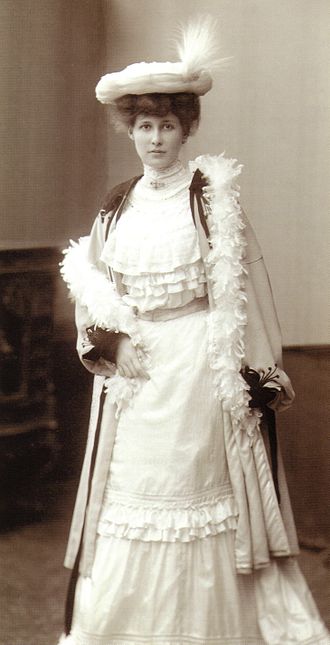Ita Wegman

Ita Wegman (22 February 1876 – 4 March 1943) co-founded Anthroposophical Medicine with Rudolf Steiner. In 1921, she founded the first anthroposophical medical clinic in Arlesheim, known until 2014 as the Ita Wegman Clinic.[1] She also developed a special form of massage therapy, called rhythmical massage, and other self-claimed therapeutic treatments.
Early life and education
[edit]Ita Wegman, as she was known throughout her life, was born as Maria Ita Wegman in 1876 in Karawang, West Java, the first child of a Dutch colonial family. Around the turn of the century, she returned to Europe (she had visited before) and studied therapeutic gymnastics and massage. In 1902, when she was 26, she met Rudolf Steiner for the first time. Five years later, she began medical school at the University of Zurich, where women were not discriminated to study medicine. She was granted a diploma as a medical doctor in 1911 with a specialization in women's medicine and joined an existing medical practice.
Career
[edit]
In 1917, having opened an independent practice, she developed a cancer treatment using an extract of mistletoe following indications from Steiner. This first remedy, which she called Iscar, was later developed into Iscador and has become an complementary cancer treatment in Germany and a number of other countries,[2] and is undergoing clinical trials in the U.S.A.[3] There is no evidence that Iscador heals cancer or improves the quality of life of cancer patients.[4][5][6][7]
By 1919 she had a joint practice together with two other doctors, also women. In 1920 she purchased land in Arlesheim, where she opened her own clinic, the Klinisch-Therapeutisches Institut, or Clinical-Therapeutic Institute, the next year. A number of other doctors joined the institute, which grew steadily over the next years as a first center for anthroposophical medicine. In 1922 she founded a therapeutic home for mentally disabled children, Haus Sonnenhof, also in Arlesheim, and co-founded a pharmaceutical laboratory, Weleda, that has since grown into a significant producer of medicines and health-care products.
In the following year, Rudolf Steiner asked Wegman to join the Executive Council of the newly reformed Anthroposophical Society at the Goetheanum in Dornach, Switzerland. She also directed the Medical Section of the research center at the Goetheanum. Together, Wegman and Steiner wrote what was to be Steiner's last book, Extending Practical Medicine (earlier editions were published as Fundamentals of Therapy), which gave a theoretical basis to the new medicine they were developing. The book was partly written while Wegman cared for Steiner, who was already terminally ill. Wegman founded a new medical journal, Natura, the following year.
In 1936, the clinic opened a second home in Ascona, Switzerland. Shortly thereafter, difficulties between Wegman and the rest of the Executive Council flared up, and Wegman was asked to leave the council; in addition, she and a number of supporters had their membership in the Anthroposophical Society itself withdrawn. The medical work flourished, however, and Wegman travelled extensively in support of the rapidly growing movement to extend medicine's limits; she was especially active in the Netherlands and England during this time.
Wegman died in Arlesheim in 1943, at the age of 67.
See also
[edit]References
[edit]- ^ Arlesheim Klinik, http://www.klinik-arlesheim.ch/de/klinik-arlesheim/
- ^ Kienle, Kiene and Albonico, Anthroposophic Medicine, Schattauer 2006 ISBN 3-7945-2495-0, Chapter 3 and 6
- ^ "Mistletoe Extracts (PDQ®)". National Cancer Institute. 8 June 2023. Retrieved 22 August 2023.
Although mistletoe was found to be therapeutically effective in most of the reported studies, many of the studies had one or more major design weaknesses as mentioned above that raised doubts about the reliability of the findings. These weaknesses include the following:
- ^ Quang, Tony S.; Taft, Michelle S.; Beriwal, Sushil (2022). Understanding The Principles and Practice of Legal Oncology. McGraw Hill LLC. p. 250. ISBN 978-1-260-47408-4. Retrieved 22 August 2023.
- ^ Ades TB, ed. (2009). "Mistletoe". American Cancer Society Complete Guide to Complementary and Alternative Cancer Therapies (2nd ed.). American Cancer Society. pp. 424–428. ISBN 9780944235713.
Available evidence from well-designed clinical trials does not support claims that mistletoe can improve length or quality of life.
- ^ Lordick, Florian (21 July 2014). "Mistletoe Treatment for Cancer". Deutsches Ärzteblatt Online. Deutscher Arzte-Verlag GmbH: 491–2. doi:10.3238/arztebl.2014.0491. ISSN 1866-0452. PMC 4150025.
Mistletoe has been used to treat cancer patients for a century, and this era, which has been mostly one of therapeutic impotence, is now ending. ... In the 1920s, the New England Journal of Medicine published multiple articles on the treatment of hypertension with mistletoe extracts (12), but, as the pathophysiology of hypertension became clearer and effective treatments for it were developed, mistletoe disappeared from cardiovascular medicine. Something similar may well happen in the domain of oncology.
- ^ de Giorgio A, Stebbing J (2013). "Mistletoe: for cancer or just for Christmas?". Lancet Oncol. 14 (13): 1264–5. doi:10.1016/S1470-2045(13)70560-6. PMID 24275128.